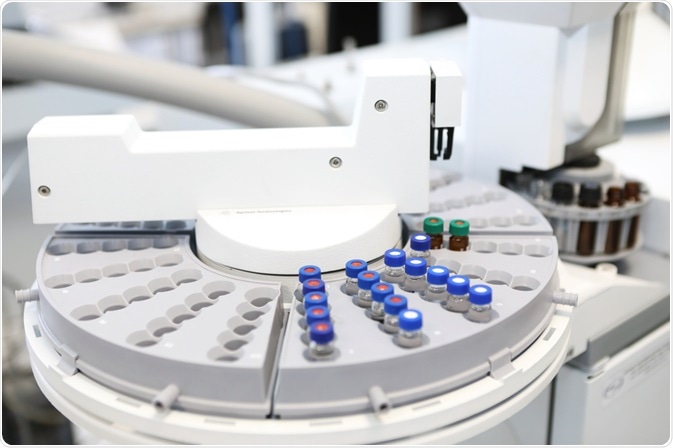The Sars-CoV-2 virus has caused a pandemic which has led to nearly 100 million cases globally by the end of 2020. The development of effective vaccines and treatments by companies and governments worldwide has gathered pace at an unprecedented speed, and robust analytical methods have been employed by researchers worldwide. This article will discuss the role chromatography techniques have played in the development of our response to the global pandemic.
 Image Credit: Cergios / Shutterstock.com
Image Credit: Cergios / Shutterstock.com
Chromatography
First devised by Mikhail Tsivet in 1900, chromatography is used to separate compounds within a mixture. It involves two phases, a mobile and a stationary phase. In the mobile phase, the mixture of interest is dissolved in a fluid, which can be either a gas, solvent, or water. This is then carried through a system where a material, or the stationary phase, is affixed.
Compounds that need to be analyzed and identified are separated due to their different affinities for the affixed material in the stationary phase. This is due to different physical and chemical properties such as physical size and how strongly the compound bonds with the stationary material. These properties cause the different compounds to move at different rates, becoming affixed to the material for different periods of time. By using methods such as mass spectrometry in tandem with chromatographic techniques, a compound can be easily identified due to its known properties.
Since the invention of chromatography in the early 20th Century, there have been a plethora of techniques developed. These include planar methods such as paper chromatography and thin-layer chromatography and column-based methods such as gas chromatography and high-performance liquid chromatography. Other, more specialized, methods exist including reverse-phase liquid chromatography, chiral chromatography, and fast protein liquid chromatography.
Using RPLC to Accurately Identify the SARS-CoV-2 Spike Protein
The spike protein of the SARS-CoV-2 virus has been of particular interest as a vaccine target due to its primary role in viral pathogenesis. Whilst there is a plethora of studies that seek to categorize the spike protein’s glycopeptides and glycans, intact protein analysis using RPLC (reversed-phase liquid chromatography) may offer unique analytical insights. By refining functional and structural understanding of the intact spike protein, more effective therapies can be identified and developed.
A paired chromatography-mass spectrometry method published by Waters compared difluoroacetic acid (DFA) and formic acid (FA) modified mobile phases and demonstrated that DFA enhanced method resolving power whilst maintaining mass spectrometry compatibility. A threefold gradient peak capacity increase was achieved alongside better resolution of the less abundant proteoforms.
This study demonstrates that by modifying chromatographic methods, more detailed analytical data on structural elements of the Sars-CoV-2 virus can be provided, which aids in the development of improved therapeutics and vaccines.
Remdesivir and the Use of Liquid Chromatography Coupled with Mass Spectrometry
Remdesivir is an antiviral that has shown promise in treating COVID-19. Developed initially to treat Ebola virus, it has shown efficacy in combating several RNA viruses including MERS (a precedent coronavirus.) Remdesivir has an estimated EC50 at around 13.8 mg/L (decreased to 3.8 mg/L when used in conjunction with emetine) in inhibiting SARS-CoV-2 replication in Vero E6 cells. It was one of the first treatments approved by the FDA in the United States.
In a study published online in June 2020, liquid chromatography coupled with mass spectrometry was used to quantify remdesivir in the blood plasma of a COVID-19 patient and thus provide data on its efficacy as a treatment for SARS-CoV-2. This was a pharmokinetic study. Six different drug-free plasma were also analyzed in the study.
The study was carried out and validated according to full EMA guidelines and demonstrated a successful and effective new method for the measurement of the concentration of both remdesivir and its metabolite GS-441524 in blood plasma. By using liquid chromatography in conjunction with mass spectrometry, laboratories can gain powerful analytical data for potential COVID-19 treatments in the future.
Using Chromatography to Diagnose COVID-19 in a Breath Test
Aside from the development of treatments and vaccines, there is a need for accurate and rapid detection of COVID-19 in patients. As the symptoms of the disease can present in similar ways to other respiratory conditions such as influenza, this is vital for the early diagnosis of patients and effective treatment of the condition. Breath biochemistry is a powerful diagnostic indicator for respiratory conditions.
Diagnostic tests are usually carried out in laboratories. This, however, can be costly in both time and resources. Therefore, the need to develop point-of-care tests that do not require lab support can help speed diagnosis and protect staff from potential exposure to COVID-19. One study published online in December 2020 presented a method for rapid diagnosis using gas chromatography-ion mobility spectrometry.
The results of the study showed that there is a host-response that may be due to a combination of ketosis, inflammatory response, and gastrointestinal function. The presence of volatile organic compounds detected via this method including ethanol, acetone, methanol, and heptanal, as well as an as-yet-unidentified feature, was hypothesized to provide the basis of an effective COVID-19 breath test.
In Conclusion
Chromatography is a powerful laboratory-based analytical method that is being employed by researchers as the scientific community strives to understand the Sars-CoV-2 virus and develop better therapies, vaccines, and diagnostic tools to aid in the fight against the Covid-19 pandemic. Research such as the studies listed in this article is providing valuable insights and data on this disease and get the world back to normal.
Sources
Nguyen, J.M & Lauber, M.A – Comprehending COVID-19: Reversed-Phase Liquid Chromatography (RPLC) of Intact SARS-CoV-2 Spike Protein Waters.com [Accessed Online 5th January 2021] www.waters.com/…/…phy-rplc-of-intact-sars-cov-2-spike-protein.html
Alvarez, J.C. et al (2020) Quantification of plasma remdesivir and its metabolite GS-441521 using liquid chromatography coupled to tandem mass spectrometry. Application to a Cov-19 treated patient Clinical Chemistry and Laboratory Medicine (CCLM) 58:9 [Accessed Online 5th January 2021] https://www.degruyter.com/view/journals/cclm/58/9/article-p1461.xml
Ruszkiewicz, D.M et al (2020) Diagnosis of COVID-19 by analysis of breath with gas chromatography-ion mobility spectrometry – a feasibility study EClinical Medicine 29-30, 100609 [Accessed Online 5th January 2021] https://www.sciencedirect.com/science/article/pii/S258953702030353
Further Reading
- All Chromatography Content
- Chromatography Overview
- Gas Chromatography-Mass Spectrometry (GC-MS) Applications
- High Performance Liquid Chromatography (HPLC)
- Liquid Chromatography-Mass Spectrometry (LC-MS) Applications
Last Updated: Jan 11, 2021

Written by
Reginald Davey
Reg Davey is a freelance copywriter and editor based in Nottingham in the United Kingdom. Writing for News Medical represents the coming together of various interests and fields he has been interested and involved in over the years, including Microbiology, Biomedical Sciences, and Environmental Science.
Source: Read Full Article
